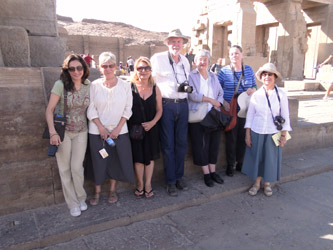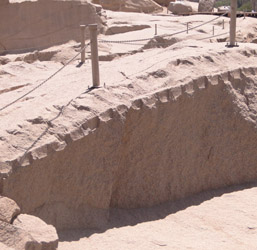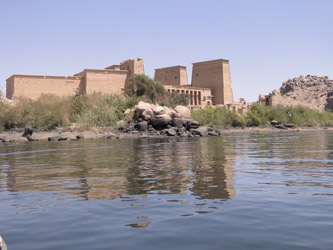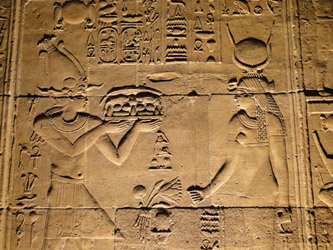


Kom Ombo - Aswan - Unfinished Obelisk - Philae
Early in the morning, before the crowds had filled the temple, we left the boat. The picture of the temple from the late 18 hundreds was taken from exactly where we had entered the temple. It was amazing what man can create, how nature like to reclaim it and yet determined man can take it back from nature. This was almost the physical image of what the history of Egypt was all about: the man trying to fight with the evil, create the most amazing and as they did create the most "immortal" grandeur, claim the name of the creator!!



The Kom Ombo temples is a complex of
two temples fused to make a one huge temple. The left part is
 dedicated
to the Falcon headed God Horus the Elder, a solar warrior God, the
exterminator of the enemies of Osiris, represented by the wing sun disc. With
his grand wings, he protects the from the evil spirits and harm and is therefore
depicted on all the entrance portals. the right side is consecrated to the
crocodile god Sobek. God Sobek was a ancient divinity to whom the creation of
the world is attributed. He also
dedicated
to the Falcon headed God Horus the Elder, a solar warrior God, the
exterminator of the enemies of Osiris, represented by the wing sun disc. With
his grand wings, he protects the from the evil spirits and harm and is therefore
depicted on all the entrance portals. the right side is consecrated to the
crocodile god Sobek. God Sobek was a ancient divinity to whom the creation of
the world is attributed. He also
 represented
fertility, exterminator of the enemies of Osiris and therefore like Horus
the Elder, he was a powerful enemy of the evil. Ptolemies had completely
reconstructed this temple which was built a thousand years before their time.
During the Roman Era, the roman emperors. Domitian and Caracalla had their
images depicted on the walls in the very Egyptian style. The temple was found
buried in the dessert sand in the late 1800s. The whole temple was completely
excavated. This is our last day together. Tonight Linda and Rich will leave for
Cairo to catch their early flight to the USA tomorrow morning. we have been
traveling together since the 14th of April more than 3 weeks. It will be
difficult to say good bye.
represented
fertility, exterminator of the enemies of Osiris and therefore like Horus
the Elder, he was a powerful enemy of the evil. Ptolemies had completely
reconstructed this temple which was built a thousand years before their time.
During the Roman Era, the roman emperors. Domitian and Caracalla had their
images depicted on the walls in the very Egyptian style. The temple was found
buried in the dessert sand in the late 1800s. The whole temple was completely
excavated. This is our last day together. Tonight Linda and Rich will leave for
Cairo to catch their early flight to the USA tomorrow morning. we have been
traveling together since the 14th of April more than 3 weeks. It will be
difficult to say good bye.
 Aswan
is where Egypt ends and the land of the Nubians begins. Trade and barter went on
here as early as the third millennium. Nubia, whose ancient name was written as
"nbw" means 'gold' ,has always been a land of conquest and
exploitation/ the doorway to black Africa, the only communications route between
sea and the heart of the continent, Nubia had provided the Egyptian Kings with
the best soldiers, highly prized woods, precious ivory, perfumes and spices as
well as gold. the pink granite which was so widely used in the ancient Egyptian
temple construction came from its many rich quarries. Aswan was also very
important in controlling the river its modern name, Aswan, is derived from
the old Egyptian "swenet" meaning " trade" .transformed to "Suan" and then
Aswan. Now Aswan has a population of close to one million people. the income is
still trade and tourism. The Aswan dam is one other site of attraction besides
the wonderful ancient temples of the ancient kingdom, the Hellenistic and the
roman eras of Egypt.
Aswan
is where Egypt ends and the land of the Nubians begins. Trade and barter went on
here as early as the third millennium. Nubia, whose ancient name was written as
"nbw" means 'gold' ,has always been a land of conquest and
exploitation/ the doorway to black Africa, the only communications route between
sea and the heart of the continent, Nubia had provided the Egyptian Kings with
the best soldiers, highly prized woods, precious ivory, perfumes and spices as
well as gold. the pink granite which was so widely used in the ancient Egyptian
temple construction came from its many rich quarries. Aswan was also very
important in controlling the river its modern name, Aswan, is derived from
the old Egyptian "swenet" meaning " trade" .transformed to "Suan" and then
Aswan. Now Aswan has a population of close to one million people. the income is
still trade and tourism. The Aswan dam is one other site of attraction besides
the wonderful ancient temples of the ancient kingdom, the Hellenistic and the
roman eras of Egypt.

 The
Granite Quarries and the unfinished obelisk
The
Granite Quarries and the unfinished obelisk
The ancient quarries which furnished Egypt with granite can still
be seen behind modern Aswan. the unfinished obelisk lies on its situ giving a
good idea of how these huge monolithique pieces were quarried. they carved the
rock from the top and the sides. then to detach the obelisk from the bottom they
drilled wholes and placed pieces of wood in the wholes and soaked the wood wet.
When the wood expanded, the rock would be detached from the ground. The
unfinished obelisk was never detached since they had found cracks in the
rock. If it were detached it would have weighed 1.150 tons.
Visiting the obelisk site was the most difficult visit. for the first time since we arrived in Egypt the temperature was more than 100F and there was no shade, But every bit of effort was absolutely worth it.





In the middle of a fascinating landscape of
granite rocks, the sacred island, the domain of the Goddess Isis raises
its columns and pillars towards the cloudless sky. Philae was the largest of the
three islands in the south of Aswan. the temple was originally on one of
the smaller islands. When the small island was flooded with the waters of the
Nile river, the temple was carried to Philea.
This temple was dedicated to Isis who with the force of her love recomposed the
scattered pieces of Osiris . The cult of the goddess on this island dates to the
earliest era of the Egyptian history. In only 535AD under the reighn of
the Byzantine emperor Justinian, the priests who were dedicated to the cult were
removed.
,